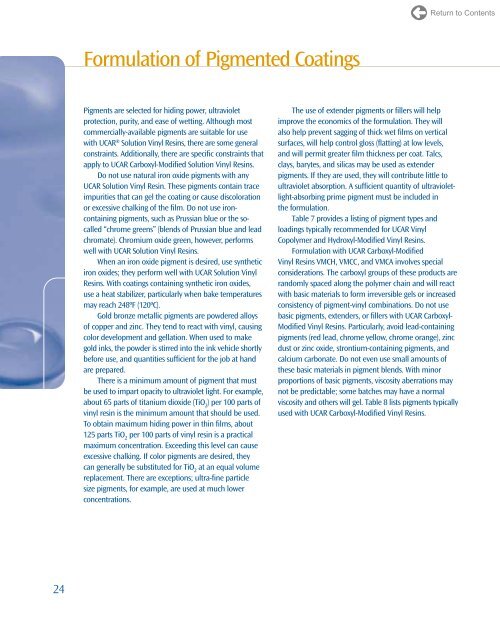You also want an ePaper? Increase the reach of your titles
YUMPU automatically turns print PDFs into web optimized ePapers that Google loves.
24<br />
Formulation of Pigmented Coatings<br />
Pigments are selected for hiding power, ultraviolet<br />
protection, purity, and ease of wetting. Although most<br />
commercially-available pigments are suitable for use<br />
with UCAR® Solution <strong>Vinyl</strong> <strong>Resins</strong>, there are some general<br />
constraints. Additionally, there are specific constraints that<br />
apply to UCAR Carboxyl-Modified Solution <strong>Vinyl</strong> <strong>Resins</strong>.<br />
Do not use natural iron oxide pigments with any<br />
UCAR Solution <strong>Vinyl</strong> Resin. These pigments contain trace<br />
impurities that can gel the coating or cause discoloration<br />
or excessive chalking of the film. Do not use ironcontaining<br />
pigments, such as Prussian blue or the socalled<br />
“chrome greens” (blends of Prussian blue and lead<br />
chromate). Chromium oxide green, however, performs<br />
well with UCAR Solution <strong>Vinyl</strong> <strong>Resins</strong>.<br />
When an iron oxide pigment is desired, use synthetic<br />
iron oxides; they perform well with UCAR Solution <strong>Vinyl</strong><br />
<strong>Resins</strong>. With coatings containing synthetic iron oxides,<br />
use a heat stabilizer, particularly when bake temperatures<br />
may reach 248ºF (120ºC).<br />
Gold bronze metallic pigments are powdered alloys<br />
of copper and zinc. They tend to react with vinyl, causing<br />
color development and gellation. When used to make<br />
gold inks, the powder is stirred into the ink vehicle shortly<br />
before use, and quantities sufficient for the job at hand<br />
are prepared.<br />
There is a minimum amount of pigment that must<br />
be used to impart opacity to ultraviolet light. For example,<br />
about 65 parts of titanium dioxide (TiO 2 ) per 100 parts of<br />
vinyl resin is the minimum amount that should be used.<br />
To obtain maximum hiding power in thin films, about<br />
125 parts TiO 2 per 100 parts of vinyl resin is a practical<br />
maximum concentration. Exceeding this level can cause<br />
excessive chalking. If color pigments are desired, they<br />
can generally be substituted for TiO 2 at an equal volume<br />
replacement. There are exceptions; ultra-fine particle<br />
size pigments, for example, are used at much lower<br />
concentrations.<br />
The use of extender pigments or fillers will help<br />
improve the economics of the formulation. They will<br />
also help prevent sagging of thick wet films on vertical<br />
surfaces, will help control gloss (flatting) at low levels,<br />
and will permit greater film thickness per coat. Talcs,<br />
clays, barytes, and silicas may be used as extender<br />
pigments. If they are used, they will contribute little to<br />
ultraviolet absorption. A sufficient quantity of ultravioletlight-absorbing<br />
prime pigment must be included in<br />
the formulation.<br />
Table 7 provides a listing of pigment types and<br />
loadings typically recommended for UCAR <strong>Vinyl</strong><br />
Copolymer and Hydroxyl-Modified <strong>Vinyl</strong> <strong>Resins</strong>.<br />
Formulation with UCAR Carboxyl-Modified<br />
<strong>Vinyl</strong> <strong>Resins</strong> VMCH, VMCC, and VMCA involves special<br />
considerations. The carboxyl groups of these products are<br />
randomly spaced along the polymer chain and will react<br />
with basic materials to form irreversible gels or increased<br />
consistency of pigment-vinyl combinations. Do not use<br />
basic pigments, extenders, or fillers with UCAR Carboxyl-<br />
Modified <strong>Vinyl</strong> <strong>Resins</strong>. Particularly, avoid lead-containing<br />
pigments (red lead, chrome yellow, chrome orange), zinc<br />
dust or zinc oxide, strontium-containing pigments, and<br />
calcium carbonate. Do not even use small amounts of<br />
these basic materials in pigment blends. With minor<br />
proportions of basic pigments, viscosity aberrations may<br />
not be predictable; some batches may have a normal<br />
viscosity and others will gel. Table 8 lists pigments typically<br />
used with UCAR Carboxyl-Modified <strong>Vinyl</strong> <strong>Resins</strong>.


